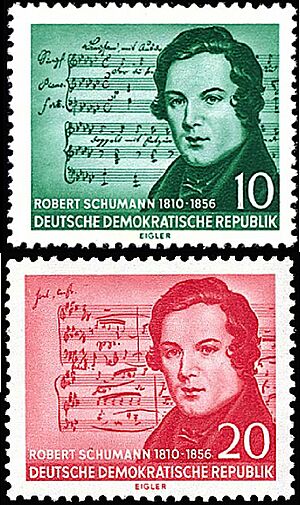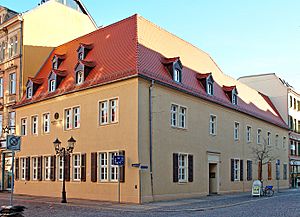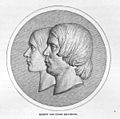Robert Schumann facts for kids
Quick facts for kids
Robert Schumann
|
|
|---|---|

Schumann in 1839, age 29
lithograph by Josef Kriehuber |
|
| Born | 8 June 1810 |
| Died | 29 July 1856 (aged 46) |
| Nationality | German |
| Occupation | Pianist, composer |
| Spouse(s) | |
| Children |
|
| Parent(s) |
|
| Signature | |
 |
|
Robert Schumann (born in Zwickau, Germany, on June 8, 1810; died July 29, 1856) was a very famous German composer. He lived during the Romantic period of music. Robert had planned to be a concert pianist, but he hurt his hand and could not continue playing professionally.
Instead, he focused on composing and writing about music. He even started a music magazine and wrote many articles about new music. His music is very emotional, which is typical of the Romantic style. Many of his pieces have titles that tell a story or describe a feeling, and they were often inspired by literature. He wrote a lot of piano music, some of which is challenging to play, but other pieces are quite easy. Many young musicians learn songs from his Album for the Young. His Lieder (German songs) are considered some of the best ever written. He also composed larger works like symphonies, concertos, and chamber music. Robert Schumann sometimes felt very happy and at other times felt very sad. These changes in his mood can often be heard in his music.
Contents
Robert Schumann's Life Story
Robert Schumann was the youngest of five children. His father was a bookseller and publisher. As a boy, Robert loved reading the books in his father’s shop. He started composing music when he was just seven years old. At school, he was excellent at both music and literature. He passed his final exams with very high scores.
His family wanted him to become a lawyer, so he went to Leipzig to study law. However, he was much more interested in music and books. He took piano lessons from a teacher named Friedrich Wieck. Mr. Wieck had a nine-year-old daughter named Clara, who was an amazing pianist. She was a child prodigy, meaning she was incredibly talented at a young age. Many years later, Clara would become Robert's wife.
Robert began to compose short piano pieces and songs. He greatly admired the music of Schubert. When he heard that Schubert had died, he was so sad that he cried all night. Robert often practiced the piano for seven hours a day. However, he started having problems with his fingers. It is believed he might have hurt his hands trying to stretch them. Whatever the reason, he could no longer be a concert pianist. He then spent the rest of his life composing and writing about music. Many of his articles appeared in a journal he started called Neue Zeitschrift für Musik (New Journal for Music).
In 1834, Robert became engaged to a girl named Ernestine. But he soon realized he was in love with Clara Wieck. Clara’s parents did not want her to marry him, and her father tried very hard to stop the marriage. Despite this, Robert and Clara were married in 1840.
Robert experienced big changes in his mood, sometimes feeling very happy and energetic, and other times feeling very sad and low. When he was feeling down, he hardly wrote any music. But 1840 was a very happy year for him, and he wrote many songs and orchestral pieces. In 1841, he composed four symphonies. In 1842, Robert and Clara went on a concert tour together. Robert found it a bit difficult because Clara was more famous than he was at the time. He returned to Leipzig alone to work on his publishing. He felt sad again during this period.
He was happy again when Clara returned, and he composed some chamber music. In 1844, they toured Russia and even played for the Tsar. By August, Robert had a complete nervous breakdown and found it hard to listen to his own music. It took him some time to get better.
By this time, Robert was skilled at writing all kinds of music. He wrote music for the famous play Faust by Goethe. In 1849, he wrote one opera called Genoveva. His fame grew slowly. For many years, only Dresden and Leipzig knew his music well. In 1850, he became the musical director in Düsseldorf. In 1853, he met Brahms, who became a great friend of the Schumann family. Robert wrote an article in his Neue Zeitschrift für Musik titled “Neue Bahnen” (“New Paths”). In it, he predicted that Brahms, who was only 20, would become a very great composer. Robert was right!
Robert had often struggled with his mental health. On February 27, 1854, he had a very difficult time and was taken to a special hospital. He spent the last two years of his life there. He passed away on July 29, 1856.
Schumann's Famous Music
Robert Schumann’s piano music is very well known. Even though he couldn't continue as a pianist, his wife Clara played his pieces and helped them become famous. Many of his piano works are collections of short pieces, each with a title. Examples include Papillons (meaning Butterflies), Davidsbündlertänze, and Carnaval. Schumann was thinking of carnival celebrations when he wrote these pieces. The Davidsbündler was a group of people Schumann imagined who fought against "Philistines." These "Philistines" were people who didn't appreciate good music.
In Carnaval, you can hear the two sides of Schumann’s personality, represented by characters named Florestan and Eusebius. His changes in mood, from happy to sad, are often heard side by side in his music. Other piano works include Kreisleriana and Album for the Young, which has some easy pieces like Soldier’s March. Another popular work is Scenes from Childhood, with its famous Träumerei (meaning Dreaming). He also wrote longer piano works like three sonatas, a Toccata, and a Phantasie.
His chamber music includes string quartets and a very famous piano quintet.
Schumann was one of the greatest composers of Lieder (German songs). He chose poems by famous German poets and set them to music in very creative ways. The piano parts in his songs are very interesting. They help to show the meaning of the words. He wrote a song-cycle called Dichterliebe (Poet’s Love), which uses poems by Heinrich Heine. Another song-cycle is Frauenliebe und -leben (Woman’s Love and Life), with words by Adalbert von Chamisso.
When he was young, Schumann seemed to prefer writing short pieces. But he became more interested in longer works after meeting Mendelssohn. He was also inspired to write symphonies after he found Schubert’s Symphony No. 9. No one knew Schubert had written it until Schumann discovered it in a box at Schubert’s brother's house in Vienna.
Schumann wrote four symphonies. One of his best is the Third, often called the Rhenish Symphony, named after the River Rhine. The Fourth Symphony in D minor is also a great work. In it, he uses just a few musical ideas and develops them in many ways to create a long, four-movement piece. His piano concerto is a great favorite. Clara Schumann played it with the Leipzig Gewandhaus Orchestra at its first performance on New Year's Day 1846.
After Robert’s death, Clara dedicated herself to playing her husband’s music and helping it become well known. She visited England often to play concerts. She also edited many of Schumann’s works for the publisher Breitkopf und Härtel.
Robert Schumann's Legacy

Schumann had a big influence on music in the 1800s and beyond. He created many praised musical works in almost every style known at the time. Thanks partly to his student, Brahms, Schumann's ideas and musical style spread widely. The famous composer Sir Edward Elgar even called Schumann "my ideal."
Schumann has sometimes been confused with the Austrian composer Franz Schubert. A funny example happened in 1956. East Germany released two postage stamps with Schumann's picture. But the music shown on the stamps was actually Schubert's! The stamps were quickly replaced with new ones that showed Schumann's own music.
Instruments Robert Schumann Used
One of the most famous instruments Robert Schumann played was a grand piano made by Conrad Graf. Graf gave this piano to Robert and Clara as a wedding present in 1839. This piano was in Schumann's workroom in Düsseldorf. Later, Clara Schumann gave it to Johannes Brahms. After being moved a few times, it was given to the Gesellschaft der Musikfreunde and can now be seen at the Kunsthistorisches Museum in Vienna.
Compositions
- List of compositions by Robert Schumann
- Category:Compositions by Robert Schumann
Robert Schumann in Movies
- Dreaming (1944) is a German movie where Mathias Wieman plays Schumann and Hilde Krahl plays Clara Wieck.
- Song of Love (1947) is an American film starring Paul Henreid as Schumann and Katharine Hepburn as Clara Wieck.
- Peter Schamoni's 1983 movie Frühlingssinfonie (Spring Symphony) tells the story of Robert and Clara's romance, and how her father tried to stop them.
- Geliebte Clara ("Beloved Clara") was a 2008 film from France, Germany, and Hungary about the lives of Clara and Robert.
- Longing is a 2000 book by American author J. D. Landis that tells a story about Schumann's life.
Images for kids
-
Clara Wieck in a picture from around 1839
-
Friedrich Wieck in a drawing from around 1838
-
The grave of Robert and Clara Schumann in Bonn
-
Robert Schumann monument at his birthplace Zwickau, Germany
See also
 In Spanish: Robert Schumann para niños
In Spanish: Robert Schumann para niños













